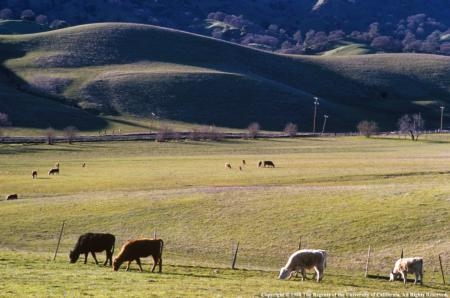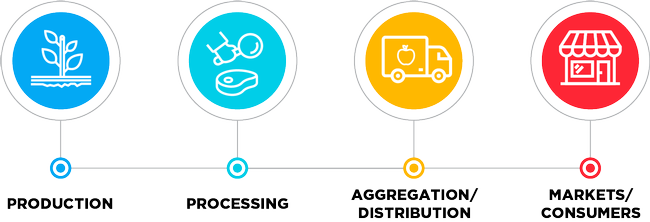
Posts Tagged: Meat processing
USDA Offers Resources to Expand Meat Processing
USDA Offers Resources to Expand Meat Processing
The U.S. Department of Agriculture announced late last week the launch of the Meat and Poultry Processing Capacity Technical Assistance Program to provide technical assistance to meat and poultry grant applicants and grant-funded projects.
Processors and applicants involved with the Meat and Poultry Inspection Readiness Grant program and the Meat and Poultry Processing Expansion Program can access this technical assistance. USDA also announced it is now accepting applications for $23.6 million in competitive grant funding available through the MPIRG program.
Click Herefor more information.
Source: USDA
CDFA New Regulations on Euthanasia
CDFA has a issued a set of new regulations on the use of drugs and on how to identify animals that are to be euthanized. There are 3 attachments. Two card summaries plus a handout for printing and keeping as reminders.
Euthanized Animal Carcass Marking12.2.20
Euthanasia Rendering (Postcard)
Euthanasia Rendering v2
USDA to Invest More Than $4 Billion to Strengthen Food System
Important News from USDA for anyone interested in Local Meat!
WASHINGTON, June 8, 2021 – Citing lessons learned from the COVID-19 pandemic and recent supply chain disruptions, the U.S. Department of Agriculture (USDA) today announced plans to invest more than $4 billion to strengthen critical supply chains through the Build Back Better initiative. The new effort will strengthen the food system, create new market opportunities, tackle the climate crisis, help communities that have been left behind, and support good-paying jobs throughout the supply chain. Today's announcement supports the Biden Administration's broader work on strengthening the resilience of critical supply chains as directed by Executive Order 14017 America's Supply Chains. Funding is provided by the American Rescue Plan Act and earlier pandemic assistance such as the Consolidated Appropriations Act of 2021.
Secretary Vilsack was also named co-chair of the Administration's new Supply Chain Disruptions Task Force. The Task Force will provide a whole of government response to address near-term supply chain challenges to the economic recovery. The Task Force will convene stakeholders to diagnose problems and surface solutions—large and small, public or private—that could help alleviate bottlenecks and supply constraints related to the economy's reopening after the Administration's historic vaccination and economic relief efforts.
USDA will invest more than $4 billion to strengthen the food system, support food production, improved processing, investments in distribution and aggregation, and market opportunities. Through the Build Back Better initiative, USDA will help to ensure the food system of the future is fair, competitive, distributed, and resilient; supports health with access to healthy, affordable food; ensures growers and workers receive a greater share of the food dollar; and advances equity as well as climate resilience and mitigation. While the Build Back Better initiative addresses near- and long-term issues, recent events have exposed the immediate need for action. With attention to competition and investments in additional small- and medium-sized meat processing capacity, the Build Back Better initiative will spur economic opportunity while increasing resilience and certainty for producers and consumers alike.
“The COVID-19 pandemic led to massive disruption for growers and food workers. It exposed a food system that was rigid, consolidated, and fragile. Meanwhile, those growing, processing and preparing our food are earning less each year in a system that rewards size over all else,” said Agriculture Secretary Tom Vilsack. “The Build Back Better initiative will make meaningful investments to build a food system that is more resilient against shocks, delivers greater value to growers and workers, and offers consumers an affordable selection of healthy food produced and sourced locally and regionally by farmers and processors from diverse backgrounds. I am confident USDA's investments will spur billions more in leveraged funding from the private sector and others as this initiative gains traction across the country. I look forward to getting to work as co-chair of the new Supply Chain Disruptions Task Force and help to mobilize a whole-of-government effort to address the short-term supply challenges our country faces as it recovers.”
The Build Back Better Initiative will strengthen and transform critical parts of the U.S. food system. As it makes investments through this initiative, USDA will also seek to increase transparency and competition with attention to how certain types of conduct in the livestock markets and the meat processing sector have resulted in thinly-traded markets and unfair treatment of some farmers, ranchers and small processors. Among other investments in the food system and food supply chain, Build Back Better will specifically address the shortage of small meat processing facilities across the country as well as the necessary local and regional food system infrastructure needed to support them.
Funding announcements under the Build Back Better initiative will include a mix of grants, loans, and innovative financing mechanisms for the following priorities, each of which includes mechanisms to tackle the climate crisis and help communities that have been left behind, including:
- Food Production: Food production relies on growers, including farmers and ranchers, workers, and critical inputs. But a diminishing share of the food dollar goes to these essential workers. USDA will invest in the current and future generation of food producers and workers throughout the food system with direct assistance, grants, training and technical assistance, and more.
- Food Processing: The pandemic highlighted challenges with consolidated processing capacity. It created supply bottlenecks, which led to a drop in effective plant and slaughter capacity. Small and midsize farmers often struggled to compete for processing access. USDA will make investments to support new and expanded regional processing capacity.
- Food Distribution & Aggregation: Food aggregation and distribution relies on people working together throughout the food system and having the right infrastructure to gather, move and hold the food where and when it is needed. This system was stressed during the pandemic due to long shipping distances and lack of investment in local and regional capacity. USDA will make investments in food system infrastructure that can remain resilient, flexible and responsive.
- Markets & Consumers: The U.S. spends more on health care and less on food than any other high-income nation; yet the U.S. has higher rates of diet-related illness and a lower life expectancy than those nations. At the same time, many socially disadvantaged and small and mid-sized producers do not have equitable access to markets. USDA will support new and expanded access to markets for a diversity of growers while helping eaters access healthy foods.
USDA will continue to make announcements through the Build Back Better initiative in the months to come. Today's announcement is in addition to the $1 billion announced last week to purchase healthy food for food insecure Americans and build food bank capacity, putting the total announced thus far at more than $5 billion.
USDA touches the lives of all Americans each day in so many positive ways. In the Biden-Harris Administration, USDA is transforming America's food system with a greater focus on more resilient local and regional food production, fairer markets for all producers, ensuring access to safe, healthy and nutritious food in all communities, building new markets and streams of income for farmers and producers using climate smart food and forestry practices, making historic investments in infrastructure and clean energy capabilities in rural America, and committing to equity across the Department by removing systemic barriers and building a workforce more representative of America. To learn more, visit www.usda.gov.
#
USDA is an equal opportunity provider, employer, and lender.
Marin County May Change Ordinance to Help Livestock Producers Harvest and Process Locally
This is a re-post from CWGA.
CWGA Legislative Action Alert – Members located in Marin County and Surrounding Areas:
Marin County is in the process of correcting an omission in the land use code that for the last 15 years has left ranchers in Marin without a pathway to commercial livestock slaughter in the county. On March 14th, the Board of Supervisors will meet to consider changes to the development code that would allow ranchers to conduct small-scale on-farm slaughter of poultry as well as allow a mobile slaughter unit to provide small-scale USDA-licensed slaughter of all species on ranches in the county. Both of these proposed rules would make it possible for ranchers to bring product to market without traveling across the state, submitting animals to stressful travel and costing the farms time and money. Anyone who has an interest in Marin's ranching community and/or locally produced meat should plan to write letters to the Board of Supervisors and speak at the March 14th meeting. Letters can be sent to the Board of Supervisors at BOS@marincounty.org.
The proposed rules would specifically allow:
1. On-farm slaughter by a rancher of his/her own poultry (chickens, turkeys, ducks, geese) for commercial sale without a use permit. This would be limited to 20,000 chickens (or equivalent) per year and only in lands zoned A3 - A60 (lands zoned A2 or ARP as well as those located in the Coastal Zone would be excluded). Ranchers would be able to process animals that are raised "on the same site or on other agricultural properties located in Marin County that are owned or leased by the processing facility owner or operator” but rabbits (traditionally included in the definition of “poultry”) would be excluded from this rule. Additionally, these processing activities would be limited to 5000 square feet.
2. Mobile Slaughter Units (MSUs) could provide USDA-licensed slaughter services to ranchers for all species without a use permit on lands zoned A3 - A60 (lands zoned A2 or ARP as well as those located in the Coastal Zone would be excluded). MSU's could not operate on any single property for more than 3 consecutive days and up to 12 total days within a calendar month unless the rancher secures a temporary use permit. Ranchers from other properties could bring their animals to where an MSU is in operation to have their animals processed. The unit would have to be located more than 100 feet away from any property lines.
3. Stationary slaughterhouses providing USDA-licensed slaughter services for all species would NOT be allowed in Marin County.
On March 14th, the Board of Supervisors has the power to approve, deny or even change these recommendations up to and including:
• Re-inserting rabbits into number 1 above.
• Allowing numbers 1 and 2 above in lands zoned A2 or ARP (the Board cannot at this time change the land use rules for farms in the Coastal Zone).
• Reversing or modifying the recommendation in number 3 in order to allow for some form of brick-and-mortar USDA slaughterhouse.
Substantial pushback from those who oppose ranching and livestock slaughter is expected at the March 14th meeting. It is very important for the Board of Supervisors to hear from the agricultural community on this issue, and members of the public who value local meats produced on local lands should also speak. Potential talking points might include:
• Raising pastured livestock is one of the oldest and most appropriate uses of Marin's coastal grasslands
• Without access to local slaughter services, ranches incur great cost in money, time and fuel to truck animals out of the area …just so they can be sold back to Bay Area consumers.
• Slaughter services are an essential part of the ranching business. Raising animals in an ecologically sound fashion is a fruitless endeavor if those animals cannot affordably be brought to market.
• New and small-scale ranchers are particularly paralyzed by the costs and complexity of working with distant slaughter facilities.
Also being recommended by the Planning Commission is a new rule to require use permits for ranchers in lands zoned ARP if they want to conduct educational tours. Until now, these activities have been considered “principally permitted” (i.e. a by-right activity that requires no permit or permission from the county). In the development code, “educational tour” is defined as: "Interactive excursion for groups and organizations for the purpose of informing them of the unique aspects of a property, including agricultural operations and environmental resources.” This has historically included school visits, chef/buyer tours, tours by organizations such as MALT or AIM, as well as open-farm type programming to help connect with new CSA members and other customers. Lands zoned A3-A60 would be unaffected by this change, but for those in ARP lands, the requirement to secure a use permit could mean $5,000-10,000 and extensive review by county Planning before allowing one of these activities to take place on your land. Given the growing interest by the public in visiting farms and ranches as well as the importance of transparency in the food system, this may pose a problem for many ranchers. Making your voice heard on this issue is recommended as well.
Again, on both matters, letters should be sent to: BOS@marincounty.org and please plan to speak on Tuesday, 3/14 (time TBD) in Suite 330 of the Marin Civic Center.
For questions contact Vince Trotter, Agricultural Ombudsman for Marin County at 415-524-7394 or marinagombudsman@gmail.com.
eXtension helps small-scale meat producers find processors
A national network for niche meat processors is being developed by eXtension to connect small-scale meat producers across the country with information, tools and each other, reported Food Safety News.
The Niche Meat Processors Assistance Network (NMPAN) was launched three years ago by co-coordinators Lauren Gwin of Oregon State University and Arion Thiboumery of Lorentz Meats of Minnesota.
"I was working for University of California Cooperative Extension, and processing kept coming up as an issue," Gwin was quoted in the story. "I found myself being the person keeping track of what different people in different parts of the state were doing on the processing question, how they could get access to processing, the venues needed. I realized it would be very valuable to have a network (of people) around the country who were also looking at this."
NMPAN hosts webinars and extends resources online via email updates. The network already includes affiliates in 40 states.
"One of the things we talk about is we need more processors and in some parts of the country that's actually true. But in some parts of the country small processors are struggling just to stay afloat because it's a very difficult industry to be in," Gwin said.
The NMPAN website includes case studies, such as one about a small USDA-inspected, family-owned slaughtering plant in Pennsylvania that handles about 45 head of cattle, 5 bison, 5 to 10 hogs and occasionally sheep and goats each week.
A detailed portrait of the company offers information about its services, prices and experiences as an example to others who might want to expand their own operations or start a facility from scratch. A Q&A conversation with the owners illustrates how farmers and the facilities they rely upon can best help each other and coordinate their efforts.
"We're just trying to keep putting together tools and get them out there that will help small processors do what they do, and will help producers find and work with existing processors and, when necessary, help them build facilities," Gwin said.

A major challenge for small-scale meat producers is finding processors.


